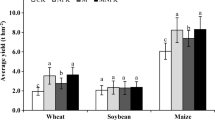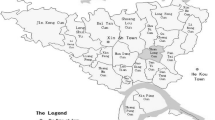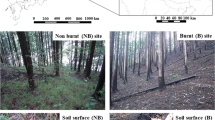Abstract
Purpose
Humic acid (HA) plays vital roles in controlling the conservation of soil and water in the forest soils. The structure of HA is closely related to its stability. A clear understanding of the structural difference of HA will facilitate the rational assessment and efficient regulation of forest soils. This study aimed to investigate the structural difference of HA in the forest soils, and the difference in the stability of HA was evaluated according to HA structure.
Materials and methods
Soils were collected from different elevations and profile depths of Jiugong Mountain (Hubei, China). Soil HA was then extracted and purified. The structure of HA was analyzed by elemental analysis, fluorescence spectroscopy, and solid-state 13C nuclear magnetic resonance (13C NMR). The stability of soil HA was comprehensively accessed by structural complexity, alkyl C/O-alkyl C ratio, and hydrophobicity of HA.
Results and discussion
The complexity of HA structure was the greatest in soils in middle elevation (1200 m a.s.l.); it tended to decrease with soil depth in all examined soils. Alkyl C (25.1–40.1%) and O-alkyl C (21.2–44.3%) were the main structural fractions in HA samples. The percentage of alkyl C was the greatest in the HA from middle elevation while the O-alkyl C proportion was the highest in the HA from lower elevation (600 m a.s.l.). Alkyl C percentage tended to decrease with soil depth while O-alkyl C showed an opposite trend. The HA aromaticity increased with soil elevation but decreased with soil depth. The hydrophobicity and alkyl C/O-alkyl C ratio of HA was the greatest in middle elevation, and these indexes tended to decrease with soil depth.
Conclusions
The HA structure in the subtropical forest soils showed clear spatial variability. The structural features of HA implied that the stability of soil HA was the greatest in the middle elevation and it tended to decrease with soil depth in the examined subtropical forest.



Similar content being viewed by others
References
Abakumov EV, Cajthaml T, Brus J, Frouz J (2013) Humus accumulation, humification, and humic acid composition in soils of two post-mining chronosequences after coal mining. J Soils Sediments 13:491–500
Almendros G, Tinoco P, de la Rosa JM, Knicker H, Pérez-González JA, González-Vila FJ (2018) Selective effects of forest fires on the structural domains of soil humic acids as shown by dipolar dephasing 13C NMR and graphical-statistical analysis of pyrolysis compounds. J Soils Sediments 18:1303–1313
Baldock JA, Oades JM, Nelson PN, Skene TM, Golchin A, Clarke P (1997) Assessing the extent of decomposition of natural organic materials using solid-state 13C NMR spectroscopy. Aust J Soil Res 35:1061–1083
Chen C, Hall SJ, Coward E, Thompson A (2020) Iron-mediated organic matter decomposition in humid soils can counteract protection. Nat Commun 11:2255
Chiu CY, Tian G (2011) Chemical structure of humic acids in biosolids-amended soils as revealed by NMR spectroscopy. Appl Soil Ecol 49:76–80
Chung TL, Chen JS, Chiu CY, Tian G (2012) 13C-NMR spectroscopy studies of humic substances in subtropical perhumid montane forest soil. J Forest Res 17:458–467
D’Orazio V, Senesi N (2009) Spectroscopic properties of humic acids isolated from the rhizosphere and bulk soil compartments and fractionated by size-exclusion chromatography. Soil Biol Biochem 41:1775–1781
D’Orazio V, Traversa A, Senesi N (2014) Forest soil organic carbon dynamics as affected by plant species and their corresponding litters: a fluorescence spectroscopy approach. Plant Soil 374:473–484
DiDonato N, Chen HM, Waggoner D, Hatcher PG (2016) Potential origin and formation for molecular components of humic acids in soils. Geochim Cosmochim Acta 178:210–222
Dodla SK, Wang JJ, Cook RL (2011) Molecular composition of humic acids from coastal wetland soils along a salinity gradient. Soil Sci Soc Am J 76:1592–1605
Dou S, Zhang JJ, Li K (2008) Effect of organic matter applications on 13C-NMR spectra of humic acids of soil. Eur J Soil Sci 59:532–539
Duarte RMBO, Fernández-Getino AP, Duarte AC (2013) Humic acids as proxies for assessing different Mediterranean forest soils signatures using solid-state CPMAS 13C NMR spectroscopy. Chemosphere 91:1556–1565
Fernández-Getino AP, Hernández Z, Piedrabuena A, Almendros G (2010) Assessment of the effects of environmental factors on humification processes by derivative infrared spectroscopy and discriminant analysis. Geoderma 158:225–232
Floch C, Alarcon-Gutiérrez E, Criquet S (2007) ABTS assay of phenol oxidase activity in soil. J Microbiol Methods 71:319–324
Hayes MHB (1998) Humic substances: progress towards more realistic concepts of structures. In: Davies G, Ghabour EA (eds) Humic Substances: Structures, Properties and Uses. Royal Society of Chemistry, Cambridge, pp 1–27
He ZQ, Cao XY, Dong MJ, Ohno T, Waldrip HM (2013) Analysis of carbon functional groups in mobile humic acid and recalcitrant calcium humate extracted from eight US soils. Pedosphere 23:705–716
Jiang L, Zhu J, Qi Y, Fu Q, Hu H, Huang Q (2017) Increasing molecular structural complexity and decreasing nitrogen availability depress the mineralization of organic matter in subtropical forest soils. Soil Biol Biochem 108:91–100
Kleber M, Eusterhues K, Keiluweit M, Mikutta R, Nico PS (2015) Mineral-organic associations: formation, properties, and relevance in soil environments. Adv Agron 130:1–140
Kögel-Knabner I (1993) Biodegradation and humification processes in forest soils. In: Stotzky G (ed) Bollag JM. Soil Biochemistry. Marcel Dekker, New York, pp 101–135
Kögel-Knabner I, Leeuw JWD, Hatcher PG (1992) Nature and distribution of alkyl carbon in forest soil profiles: implications for the origin and humification of aliphatic biomacromolecules. Sci Total Environ 117 – 118:175–185
Li Y, Nie C, Liu Y, Du W, He P (2019) Soil microbial community composition closely associates with specific enzyme activities and soil carbon chemistry in a long-term nitrogen fertilized grassland. Sci Total Environ 654:264–274
Lopez R, Gondar D, Iglesias A, Fiol S, Antelo J, Arce F (2008) Acid properties of fulvic and humic acids isolated from two acid forest soils under different vegetation cover and soil depth. Eur J Soil Sci 59:892–899
Lyu M, Xie J, Ukonmaanaho L, Jiang M, Li Y, Chen Y, Yang Z, Zhou Y, Lin W, Yang Y (2017) Land use change exerts a strong impact on deep soil C stabilization in subtropical forests. J Soils Sediments 17:2305–2317
Martin D, Srivastava PC, Ghosh D, Zech W (1998) Characteristics of humic substances in cultivated and natural forest soils of Sikkim. Geoderma 84:345–362
Martin-Neto L, Fialho LL, da Silva WTL, Milori DMBP, Simões ML (2010) Characterization of organic matter from composting of different residues by physico-chemical and spectroscopic methods. Bioresour Technol 101:1927–1934
Mikutta R, Kleber M, Torn MS, Jahn R (2006) Stabilization of soil organic matter: association with minerals or chemical recalcitrance? Biogeochemistry 77:25–56
Nelson DW, Sommers LE (1996) Total carbon, organic carbon, and organic matter. In: Black CA (ed) Methods of Soil Analysis, Part 3. Chemical Methods. Soil Science of America and American Society of Agronomy, Madison, pp 961–1010
Olk DC, Cassman KG, Fan TWM (1995) Characterization of two humic acid fractions from a calcareous vermiculitic soil: implications for the humification process. Geoderma 65:195–208
Orazio V, Traversa A, Senesi N (2014) Forest soil organic carbon dynamics as affected by plant species and their corresponding litters: a fluorescence spectroscopy approach. Plant Soil 374:473–484
Piccolo A, Spaccini R, Haberhauer G, Gerzabek MH (1999) Increased sequestration of organic carbon in soil by hydrophobic protection. Naturwissenschaften 86:496–499
Rodríguez FJ, Schlenger P, García-Valverde M (2014) Fluorescence techniques before and after ozonation. Part I: Structural characterization of humic substances. Sci Total Environ 476 – 477:718–730
Rodríguez-Murillo JC, Almendros G, Knicker H (2017) Humic acid composition and humification processes in wetland soils of a Mediterranean semiarid wetland. J Soils Sediments 17:2104–2115
Song X, Liu J, Jin S, He X, Liu S, Kong X, Dong F (2018) Differences of C sequestration in functional groups of soil humic acid under long term application of manure and chemical fertilizers in North China. Soil Tillage Res 176:51–56
Soucémarianadin LN, Cécillon L, Guenet B, Chenu C, Baudin F, Nicolas M, Girardin C, Barré P (2018) Environmental factors controlling soil organic carbon stability in French forest soils. Plant Soil 426:267–286
Spaccini R, Piccolo A, Haberhauer G, Gerzabek MH (2000) Transformation of organic matter from maize residues into labile and humic fractions of three European soils as revealed by 13C distribution and CPMAS-NMR spectra. Eur J Soil Sci 51:583–594
Spaccini R, Piccolo A, Contea P, Haberhauerb G, Gerzabekb MH (2002) Increased soil organic carbon sequestration through hydrophobic protection by humic substances. Soil Biol Biochem 34:1839–1851
Sutton R, Sposito G (2005) Molecular structure in soil humic substances: the new view. Environ Sci Technol 39:9009–9015
Tinoco P, Almendros G, González-Vila FJ, Sanz J, González-Pérez JA (2015) Revisiting molecular characteristics responsive for the aromaticity of soil humic acids. J Soils Sediments 15:781–791
Traversa A, D’Orazio V, Mezzapesa GN, Bonifacio E, Farrag K, Senesi N, Brunetti G (2014) Chemical and spectroscopic characteristics of humic acids and dissolved organic matter along two Alfisol profiles. Chemosphere 111:184–194
Ussiri DAN, Johnson CE (2003) Characterization of organic matter in a northern hardwood forest soil by 13C NMR spectroscopy and chemical methods. Geoderma 111:123–149
Van Krevelen DW (1950) Graphical-statistical method for the study of structure and reaction processes of coal. Fuel 29:269–284
Xu J, Zhao B, Chu W, Mao J, Zhang J (2017) Chemical nature of humic substances in two typical Chinese soils (upland vs paddy soil): a comparative advanced solid state NMR study. Sci Total Environ 576:444–452
Zech W, Senesi N, Guggenberger G, Kaiser K, Lehmann J, Miano TM, Miltner A, Schroth G (1997) Factors controlling humification and mineralization of soil organic matter in the tropics. Geoderma 79:117–161
Zhang J, Lv BY, Xing MY, Yang J (2015) Tracking the composition and transformation of humic and fulvic acids during vermicomposting of sewage sludge by elemental analysis and fluorescence excitation-emission matrix. Waste Manag 39:111–118
Zhang Q, Liang G, Guo T, He P, Wang X, Zhou W (2017) Evident variations of fungal and actinobacterial cellulolytic communities associated with different humified particle-size fractions in a long-term fertilizer experiment. Soil Biol Biochem 113:1–13
Funding
This research was supported by the National Key Research and Development Program of China (2018YFD0200506) and the Natural Science Foundation of China (grant number: 41877031).
Author information
Authors and Affiliations
Corresponding author
Additional information
Responsible editor: Anja Miltner
Publisher’s note
Springer Nature remains neutral with regard to jurisdictional claims in published maps and institutional affiliations.
Rights and permissions
About this article
Cite this article
Jiang, L., Zhu, J., Wang, H. et al. Spatial variability of the molecular composition of humic acids from subtropical forest soils. J Soils Sediments 21, 766–774 (2021). https://doi.org/10.1007/s11368-020-02862-2
Received:
Accepted:
Published:
Issue Date:
DOI: https://doi.org/10.1007/s11368-020-02862-2




